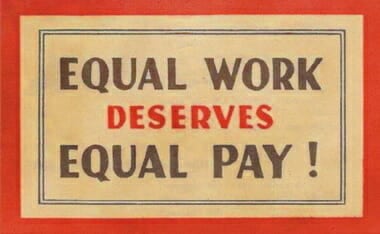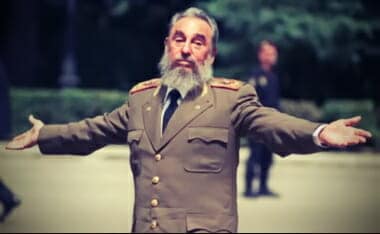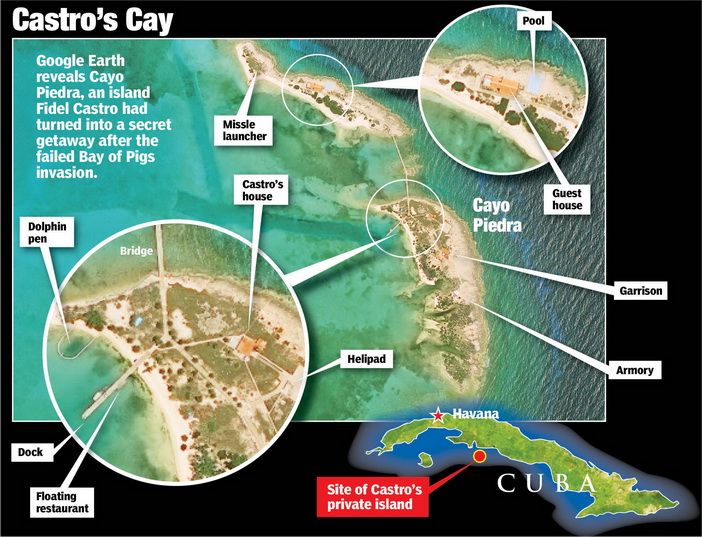Income Equality


To Live Like a King ~ Fidel Castro’s Extravagant [Capitalist] Lifestyle
See as well my previous post,
Here is part of the Wall Street Journal article Dennis is reading from:
…The legend of Castro as a great revolutionary who sacrifices for his people is preserved by keeping the details about his life a state secret. Sánchez’s account shows the real Castro: vengeful, self-absorbed and given to childish temper tantrums—aka “tropical storms.” “The best way of living with him,” Sánchez wrote, “was to accept all he said and did.”
The book is timely. The Obama administration has just removed Cuba from the U.S. list of state sponsors of terrorism amid sharp criticism from exiles. Their concerns are sensible: Though Castro is now rumored to be feebleminded, the intelligence apparatus he built—which specializes in violence to destabilize democracy and trafficks in drugs and weapons—remains as it has been for a half century.
Sánchez witnessed firsthand Castro’s indifference to Cuban poverty. The comandante gave interminable speeches calling for revolutionary sacrifice. But he lived large, with a private island, a yacht, some 20 homes across the island, a personal chef, a full-time doctor, and a carefully selected and prepared diet.
When a Canadian company offered to build a modern sports-facility for the nation, Castro used the donation for a private basketball court. Wherever he traveled in the world, his bed was dismantled and shipped ahead to ensure the comfort he demanded.
Castro was obsessed with spreading his revolution. Outside of Havana was a secret camp called Punto Cero de Guanabo where, Sánchez wrote, Cuba “trained, shaped and advised guerrilla movements [and organizations] from all over the world.” Recruits from places like Venezuela, Colombia, Chile and Nicaragua practiced hijacking airplanes and learned to use explosives.
“The Chile of Salvador Allende at the start of the 1970s,” Sánchez wrote, “was without doubt the country in which Cuban influence had penetrated most deeply. Fidel devoted enormous energies and resources to it” and he infiltrated it heavily with Cuban intelligence operatives.
Sánchez learned about what had happened in Chile from Castro’s notorious revolutionary spymaster Manuel Piñeiro, who “was always hanging around the presidential palace” talking about it.
The Cuban regime “penetrated and infiltrated [Allende’s] entourage” with the objective of creating “an unconditional ally in Santiago de Chile.” Marxists “ Miguel Enríquez, the leader of [Chile’s] Movement of the Revolutionary Left, and Andrés Pascal Allende, co-founder of that radical movement and also nephew of President Allende” were Castro protégés who trained in Cuba…
(WSJ)
(Click to Enlarge)
The public image of Cuba’s former leader Fidel Castro is that of the exemplary and frugal leader, but his bodyguard of 17 years claims it was a sham….
John Simpson interviewed Mr Sanchez for BBC’s Newsnight programme.
In May the New York Post did a larger article on this topic. In it we find more details bout this extravagant lifestyle and the “equality” Castro achieved was built on the murders of engineers, journalists, priests, gays, and other free-market believers that threatened Castro in dumbing down his population for the express purpose of easily controlling:
…Few, meanwhile, know that Fidel has had at least three children out of wedlock, including one with his personal interpreter and longtime mistress, Juanita.
Castro may not be as ostentatious as Khadafy or Saddam Hussein, but he’s rich beyond most people’s dreams. His simple appearance is due more to laziness than austerity. Castro, who rarely wakes before 10 a.m. or 11 a.m., is happy not to wear a suit and confessed that the main reason he has a beard is so he did not have to shave every day.
But there were plenty of perks to being the depository of Cuba’s wealth. He has his own private basketball court where he never lost a game. And his own private hospital housing two people full-time simply because they shared his blood type.
At Punto Cero, each member of his family possessed his or her own cow, so as to satisfy each one’s individual tastes, since the acidity and creaminess of fresh milk varies from one cow to another. And so the milk would arrive on the table, each bottle bearing a number, a little piece of paper scotch-taped onto the bottle, corresponding to each person’s cow.
Antonio’s was No. 8, Angelito’s No. 3, and Fidel’s No. 5, which was also the number he wore on his basketball shirt.
There was no question of deceiving him: Fidel possessed an excellent palate that could immediately detect if the taste of milk did not correspond to that of the previous bottle.
Perhaps most extravagantly, Fidel Castro has his own secret island.
Ironically, he has John F. Kennedy to thank for it. In April 1961, a group of CIA-trained exiles landed at the Bay of Pigs and tried to overthrow the Cuban government. It was a complete fiasco.
In the days following the failed attack, Fidel came to explore the region when he encountered a local fisherman with a wrinkled face whom everyone called El Viejo Finalé. He asked Old Finalé to give him a tour of the area, and the fisherman immediately took him on board his fishing boat to Cayo Piedra, a little “jewel” situated 10 miles from the coast and known only to the local inhabitants.
Fidel instantly fell in love with this place of wild beauty worthy of Robinson Crusoe and decided to have it for his own. The lighthouse keeper was asked to leave the premises and the lighthouse was put out of action and later taken down.
To be precise, Cayo Piedra consists of not one island but two, a passing cyclone having split it in half. Fidel had, however, rectified this by building a 700-foot-long bridge between the two parts.
The southern island was slightly larger than its northern counterpart, and it was here, on the site of the former lighthouse, that Castro and his wife, Dalia, had built their house: a cement-built, L-shaped bungalow arranged around a terrace that looked out to the east, onto the open sea.
While ordinary Cubans suffered, this is where Castro would relax.
On the west side of the island, facing the setting sun, the Castros had built a 200-foot-long landing stage for his personal yacht. The Aquarama II, decorated entirely in exotic wood imported from Angola, had four engines from Soviet navy patrollers, a gift from Soviet leader Leonid Brezhnev. At full throttle, they propelled Aquarama II at the phenomenal, unbeatable speed of 42 knots, or about 48 miles an hour.
To allow Aquarama II to dock, Fidel and Dalia had also had a half-mile-long channel dug; without this, their flotilla would not have been able to reach the island, surrounded by sand shoals.
The jetty formed the epicenter of social life on Cayo Piedra.
A floating pontoon, 23 feet long, had been annexed to it, and on the pontoon stood a straw hut with a bar and barbecue grill.
From this floating bar and restaurant, everyone could admire the sea enclosure in which, to the delight of adults and children alike, turtles (some 3 feet long) were kept. On the other side of the landing stage was a dolphinarium containing two tame dolphins that livened up our daily routines with their pranks and jumps.
Fidel Castro also let it be understood, and sometimes directly stated, that the revolution left him no possibility for respite or leisure and that he knew nothing about, and even despised, the bourgeois concept of vacation. Nothing could have been further from the truth…
[….]
The Cuban economy, which derived almost 80% of its external trade from the eastern bloc, was collapsing like a house of cards and households were surviving on the breadline while the GNP had decreased by 35% and electricity supplies were seriously inadequate.
Meanwhile, Fidel Castro sipped his whiskey on the rocks and ate fresh fish in the shade of his secret island.
(NYPost)
Income Equality Myths ~ Debunking a 99% Myth
Investors Business Daily makes some key points that are hard to ignore:
Income Inequality Rose Most Under President Clinton
…But it turns out that the rich actually got poorer under President Bush, and the income gap has been climbing under Obama.
What’s more, the biggest increase in income inequality over the past three decades took place when Democrat Bill Clinton was in the White House.
The wealthiest 5% of U.S. households saw incomes fall 7% after inflation in Bush’s eight years in office, according to an IBD analysis of Census Bureau data. A widely used household income inequality measure, the Gini index, was essentially flat over that span. Another inequality gauge, the Theil index, showed a decline.
In contrast, the Gini index rose — slightly — in Obama’s first two years. Another Census measure of inequality shows it’s climbed 5.7% since he took office.
Meanwhile, during Clinton’s eight years, the wealthiest 5% of American households saw their incomes jump 45% vs. 26% under Reagan. The Gini index shot up 6.7% under Clinton, more than any other president since 1980…
[….]
As University of Michigan economist Mark Perry notes, while the income gap has grown since 1979, almost the entire increase occurred before the mid-1990s: “There is absolutely no statistical support for the commonly held view that income inequality has been rising recently.”
A similar analysis found that income inequality has fallen among individuals since the early 1990s, but risen among households due to factors such as more marriages of people with similar education levels and earnings potential.
Others argue that income mobility matters more than equality.
One study found that more than half of the families who started in the lowest income bracket in 1996 had moved to a higher one by 2005. At the other end of the spectrum, more than 57% of families fell out of the top 1%.
Another smaller post points out nearly the same:
…The left says current levels of income inequality echo the late 1920s and the Gilded Age. They’ve zeroed in on the richest 1%, citing Census Bureau data showing these top earners “grabbing” more income than the bottom 90%.
But the census stats are misleading.
For one, they are a snapshot of income distribution at a single point in time. Yet income is not static. It changes over time. Low-paying jobs from early adulthood give way to better-paying jobs later in life.
And income groups in America are not fixed. There’s no caste system here, really no such thing even as a middle “class.” The poor aren’t stuck in poverty. And the rich don’t enjoy lifetime membership in an exclusive club.
A 2007 Treasury Department study bears this out. Nearly 58% of U.S. households in the lowest-income quintile in 1996 moved to a higher level by 2005. The reverse also held true. Of those households that were in the top 1% in income in 1996, more than 57% dropped to a lower-income group by 2005.
Every day in America, the poor join the ranks of the rich, and the rich fall out of comfort.
So even if income equality is increasing, it does not mean income mobility is decreasing. There is still a great deal of movement in and out of the richest and poorest groups in America.
Listen to Larry Elder talk about this article:

